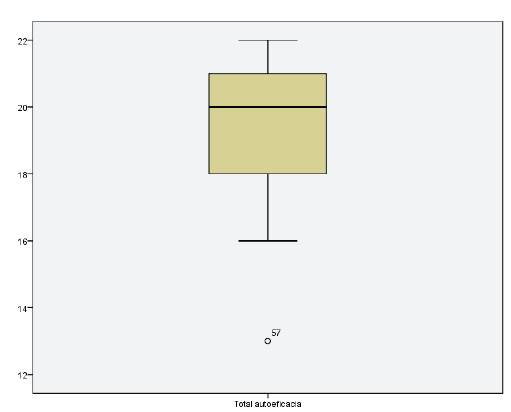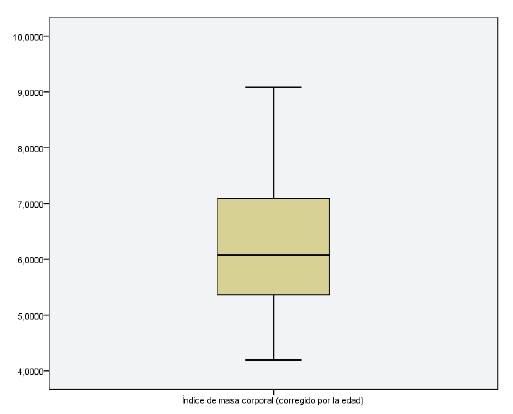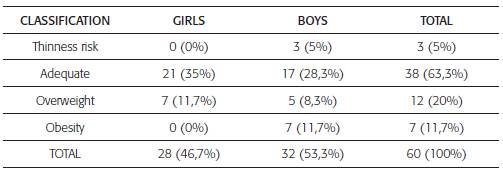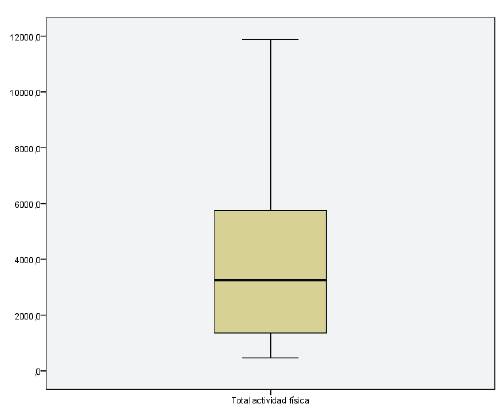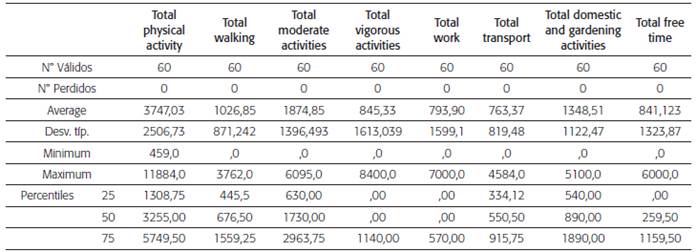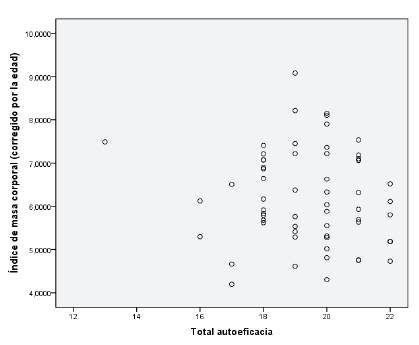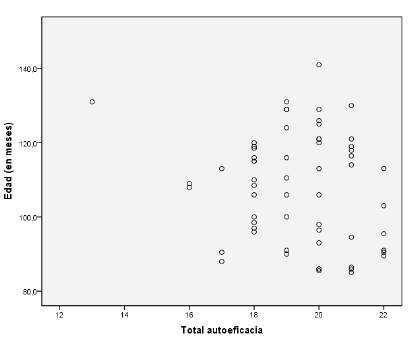INTRODUCTION
The socioeconomic aspect at a global and national level has led to an urbanization environment which has transformed the behavior of the population, even from childhood age and that are largely responsible for chronic non communicable diseases as is the example of excess weight. According to the World Health Organization (WHO) 1, sedentary lifestyle is one of the main causes of cardiovascular disease. The National Survey of Nutritional Situation in Colombia (ENSIN) 2 in 2010 published that 62% of children and teenagers (5-12 years) watch television or play video games for 2 hours or more during the day, a figure that has been increasing year after year, also reported that 13.4% of children and teenagers are overweight and 4.1% suffer obesity, thus concluding that the prevalence of overweight and obesity has increased by 25.9% in the last five years among children and teenagers.
The previously described data suggest that the children affected by overweight and obesity present factors that are definitely preventable, such as lack of physical activity (PA). But for actions taken to be effective with transcendental results when it comes to reducing excess weight in the children population with emphasis on PA, their characteristics should be very well known regarding this phenomenon, and this is where we inquire about of the capacities that they think they have to perform PA and / or in the presence of obstacles that limit it.
At this point it is essential to define physical activity not only as the action, but also how it can become a habit, and this is where it is worth highlighting that the WHO 3 in 2010 published the recommendations of PA where it is stated that all children and young people (5-17 years of age) should carry out daily physical activities in the form of games, sports, travel, recreational activities, physical education or programmed exercises, in the family context and at school for 60 or more daily minutes.
It is necessary to affirm that there are different studies that reflect a relationship between the habits of PA of the parents and the level of self-efficacy of the children, is the case of the study by Olivares et al. 4, who found that the motivations, barriers, feelings of self-efficacy and self-esteem have a significant influence on physical activity. This study reflects the manifestations of obese children from 8 to 11 years, who report that they would like to have the support of their parents; highlights such as: "I know it's good to do exercises, but I would like my parents go with me to play or ride a bike." Darling and Steinberg 5 report that the practices carried out by parents as caregivers in the first years of life influence the behavior patterns of their children. The habits that people learn from childhood are acquired thanks to the habits of their parents, therefore they are the ones who initiate the education and implementation of PA practices, among others. Likewise, García et al. 6 found in their study that fathers and mothers influence the sedentary behavior of their children.
From this influence of the parents towards their children, a relationship between these behaviors and the self-efficacy in the PA generated in the children is proposed, which in turn is related to their Body Mass Index (BMI), since by having an adequate perception of the ability to perform PA (self-efficacy), more motivating and effective feelings are obtained at the time of initiating and continuing a PA program and therefore more likely to have an adequate weight, which will be reflected in the BMI.
Nursing as a discipline and profession responsible for care, including primary health care, has the task of knowing cognitive behavioral processes, based on the factors that affect the behavior of each child according to his family environment, which entails the acquisition of healthy behaviors, such as the performance of PA as a habit, so that from there, interventions aimed at improving the health condition of the children that will be the teenagers and adults of tomorrow. Based on the above, it is essential to highlight the Self-efficacy theory created by Albert Bandura 7, who studied the human being and his cognitive-behavioral aspect; from it, different research has been released, in the health environment and in the Nursing discipline, in which Bárbara Resnick 8 has concentrated with the objective of describing how the different concepts of the theory are applied to strengthen the motivation to perform PA in the child population and thus form more active and therefore healthier citizens.
Self-efficacy is defined by Resnick 8 as the judgments of a person about their own abilities that influence their actions, since in this case it is vitally important to produce changes in behavior, also affirms that there is a relationship between self-efficacy and specific health behaviors. he concept is the product of diverse sources: own experience, vicarious experience, social persuasion and the physiological and affective state.
The subjects with a high sense of self-efficacy will be involved in activities with a high interest and commitment, investing a great effort in what they do and increasing their effort in the face of difficulties and setbacks. Bandura 9 states that self-efficacy proves to be a factor of great importance in the face of the motivation to adopt behaviors that promote health or stop harmful behaviors for it. The foregoing suggests that by using this theory, not only would it be possible to determine risk factors, but also that the person would be able to act to eliminate them and create new behaviors called protective factors.
MATERIALS AND METHODS
Acorrelational descriptive quantitative study was carried out, with a sample consisting of 60 children from 7 to 10 years of age from a school in Bogotá and their biological parents, whose main objective was to determine the correlation between self-efficacy in AF in children, their BMI and physical activity levels of parents. Inclusion criteria were children who were between 7 to 10 years and 11 months old and children who lived with their two parents or one of them and who were between 15 and 69 years of age. The exclusion criteria were given by children who had a cognitive disability and parents who had a physical disability.
To measure the self-efficacy towards PA in children, the Questionnaire to Evaluate the "Self-efficacy towards Physical Activity" was used in children aged 7 to 10 years and 11 months of Aedo and Ávila 10 which consists of 11 questions addressed, with a dichotomous response scale that measures three variables: Search for positive alternatives, Ability to overcome barriers and Expectations of ability. Each variable is classified according to the summation of its items such as: adequate or inadequate, and then the final evaluation of the entire instrument is given taking into account the sum of all variables as follows: two or more variables rated as adequate corresponds to a high self-efficacy and one or fewer variables rated as appropriate corresponds to a low self-efficacy The questionnaire is adapted to the Spanish language, has a high degree of congruence and adequate internal consistency (Construct validity:> 0.70, test-retest reliability: 0.867 and internal consistency: 0.735)
In relation to the measurement of the physical activity of the parents, the "International Phy-sicalActivity Questionnaire" (IPAQ) was used in its long version 11, which has 4 domains: PA in free time , domestic activities and in the garden, PA related to work and AP as a means of transportation, in turn interrogates about the three types of AP contained in the four domains, physical activities of vigorous intensity; Moderate intensity and walking PA, to classify the level of PA (low, moderate or high) the unit of measurement of the metabolic rate METs / min / week is used; a MET is the amount of heat emitted by a person in sitting position per square meter of skin and can have different values or multiples (walking: 3.3 MET, riding a bicycle: 6.0 MET, housework within the home: 3.0 MET, tasks in the garden and other activities of moderate intensity: 0.4 MET and vigorous activities 8,0 MET) for physical activities depending on their intensity, the MET / min / week is obtained by multiplying the MET factor assigned to each type of activity for the duration in minutes activity and for the weekly frequency. The IPAQ has a version in Spanish and has been validated at the Colombian level and has a Spearman coefficient of 0.8 and a validity of 0.3.
The Parent's definition in this study is given according to the inclusion criteria in which one or both of the student's biological parents are taken into account, as in the case of non-biological parents, additional variables such as coexistence time should be analyzed. , from what age they live together, with whom the boy or girl lived before, among others and this study did not have this scope.
For the interpretation of the IMC, the growth and development standards of WHO adopted in Colombia were taken into account through Resolution 2121 of 2010 of the Ministry of Social Protection 12, for children from 0 to 18 years of age, whose classification is given by the corresponding grid that determines the standard deviation (SD) like this:
BMI with D.E <-2: Thinness
BMI with D.E> -2 to <-1: Risk of Thinness
BMI with D.E> -1 to 1: Adequate
BMI with D.E> 1 to <2: Overweight
BMI with D.E> 2: Obesity
In this sense it is important to mention the corrected BMI concept, which emerged with the aim of operationalizing the BMI variable from the interpretation of the same value changes according to the age of the child, therefore it is obtained by dividing the BMI with age; for the respective interpretation is taken into account that the larger the number, the thinner the child is, therefore the smaller the number, the more weight the child has.
The research was endorsed by the Ethics Committee of the National University of Colombia and the ethical criteria described in Resolution 8430 of 1993 of the Ministry of Health, the Helsinki Resolution and in accordance with basic ethical principles were taken into account (respect for the people, beneficence and non-maleficence, autonomy, justice, confidentiality, reciprocity); In addition, there was informed consent and assent by the participants. It should be clarified that there was a minimum risk in its execution.
The data collection was developed in 6 stages. In stage 1, a pilot test was carried out, in stage 2 the selection of the School was made, taking into account that it had primary grades where children were found that fulfilled the inclusion criteria, and where there was not the presence of extracurricular entities that would encourage PA. In stage 3, the children and their parents were selected, who met the inclusion criteria and who, in a previously scheduled meeting of parents, were guided and informed in a clear and simple manner about the investigation, its objectives, justification, procedure to fill out the questionnaires and it was made clear that there were not erroneous answers and they only had to answer truthfully; additionaly , the explanation of the informed consent and assent was made for its later signing by those who accepted the realization of the study, previous authorization on the part of the school, for the programming and coordination. In stage 4, an interview was conducted with the parents who agreed to participate in the study with the aim of filling out the IPAQ Long version. The interview was developed in the school. In stage 5, an individual interview was conducted in a private area of the school to the children who accepted participation in the study and who had the objective of applying the Self-efficacy Questionnaire in PA. Finally, in stage 6, the anthropometric measurement of weight and height was performed in order to determine the BMI of the children. This procedure was carried out in the educational institution and was carried out by the author of the investigation.
The central analysis revolved around the correlation between the main variables supported by the Spearman and Gamma correlation coefficient and the construction of the explanatory models based on the multiple regression analysis.
RESULTS
From the data collection, only the responses of children's mothers were taken into account since the fathers who attended were insufficient to elaborate the data processing and its respective analysis.
Regarding the level of self-efficacy in PA in children, it was found that it is high, as can be seen in graph No. 1. The Search dimension of positive alternatives, 88.3% of children had it as Adequate. The dimension Ability to overcome barriers, 35% of children had inadequate, while 65% adequate. The dimension of Skill Expectations, 96.6% of children hadAdequate.
Regarding the BMI, it can be seen in graph No. 2 that the children were mostly in the classification of Adequate for the age. Table 1 shows the data found according to the BMI classification based on the graphs corresponding to the BMI for Children, Girls from 5 to 18 Years of the WHO Growth Patterns in Colombia 12.
The findings obtained for the level of PA of the mothers show that it oscillates between 459 and 11884 Multiples of Resting Metabolic Rate (METs), the average was 3747 METs. In the 25th percentile, 1308 METs are located, in 50 there are 3255 and in 75, 5749 METs are located, as can be seen in graph No. 3.
According to the amount of METs obtained in the 3 types of PA, mothers were found to have values ranging from 0 to 3762 METs; in moderate PA, mothers spend between 0 to 6095 METs and in vigorous PA it was found that mothers spend between 0 to 8400 METs.
In table 2 it can be seen that in relation to the amount of METs obtained in the domain work, mothers spend between 0 to 7000 METs; in the Transport domain they spend between 0 to 4584 METs; in the domain of domestic activities and gardening, they spend between 0 to 5100 METs; and in the domain of sports, recreation and free time, they spend between 0 to 6000 METs.
Based on the foregoing and the results found, it is noted that in the activity of Walk, mothers obtained a low level and few women met the requirement in weekly time. According to the domains it was observed that in relation to Work the physical activity is very low (0 to 570 METs.); in terms of transport, physical activity is low (334 METs at 915 METs.); at home and gardening physical activity is low (540 METs at 1890 METs.) and in free time physical activity is very low (0 to 1159 METs.).
Regarding the relationship between Self-efficacy and BMI, it can be seen in figure 4 that there is no statistically significant relationship, finding a coefficient of -0.107 (p = 0.415) and the Gamma correlation coefficient of -, 083.
For the relationship between the BMI of the children and the PA level of their mothers, in graph N°5 it can be seen that there is no relationship, finding a coefficient of relationship of 0.141 (p = 0.282), and the Gamma correlation coefficient of -, 113.
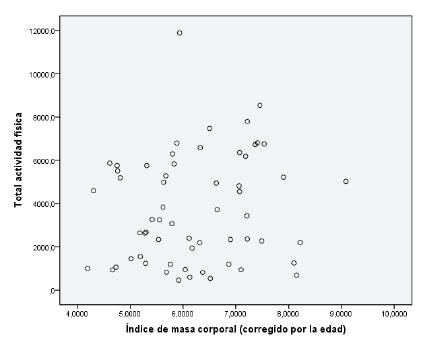
Source: Research database
Graph 5 Relationship Body Mass Index of boys and girls and level of Physical Activity of mothers
Regarding the relationship between Self-efficacy towards children's AF and their mothers' FA level, in graph 6 it can be seen that there is not relationship, finding a ratio of 0.063 (p = 0.632), and the coefficient of Gamma Correlation -, 160.
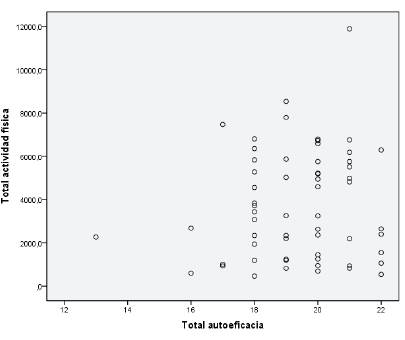
Source: Research database
Graph 6 Self-efficacy relationship in boys and girls and level of physical activity of mothers
For the relationship between age and Self-efficacy towards children's AF, in graph N°7 it can be observed that there is not relationship, finding a coefficient of relation of -0.139 (p = 0.288).
DISCUSSION
According to the data found, it can be analyzed that self-efficacy towards AFPA is high in 93.3% of boys and girls, in terms of the dimensions of Search for positive alternatives and Skill expectations is adequate; This means that most children have the capacity to explore possible alternatives for the realization of PA and that they also have sufficient confidence in their abilities to perform it properly. 35% of children have inadequate capacity to overcome barriers, which indicates that a large part of them are not searching for solutions to the obstacles they find to perform PF behavior, a fact that is important to analyze since knowing their cause it could help to identify determining factors and the forms of support to face the difficulties that prevent this activity.
Of the total of 60 children, 63.3% of them have an adequate BMI, of which 35% of the total corresponds to the female gender, 20% of the students are overweight, the female gender corresponds to 11.7% and 8.3% male gender. 11.6% have obesity, predominantly the male gender. In summary, 31.7% of the population is overweight, where children predominate with 20% compared to 11.7% of girls.
Similar results were obtained in the study carried out by Hernández 13, where it indicates that excess weight affects 24.1% of school children: overweight 15.99% and obesity 8.18%. This is where you can see that there is a tendency to increase the figures of overweight and obesity in the different regions of Colombia.
It is important to highlight that the results surpass those described by the ENSIN 2015 14, in which it was revealed that 24.4% of school children were overweight.
The above reconfirms that overweight and obesity in the child population are increasing and although it is not the majority of the population it is important to face them so that these levels do not continue to increase, starting with identifying risk factors such as low weight that is also found in 5% of children.
Based on the results found, the level of PA of the mothers when performing the summation of all the activities (walking, moderate and vigorous activities), is mostly moderate, reporting a greater percentage of METs between 1308 and 574. In addition, finding that 30 mothers perform 150 minutes per week of PA and more, which indicates that, according to the classification of the IPAQ questionnaire, they perform moderate PA. However, when performing the summation for each domain it was evident that the level of PA was generally low, as can be seen below:
Work: the physical activity that most mothers perform is very low, since they obtained between 0 to 570 METs.
Transportation: the physical activity that most mothers perform is low, since they obtained between334METs to 915 METs
House and gardening: most mothers perform between 540 METs at 1890 METs. In this domain the activity carried out is low
Free time: the physical activity that the mothers perform is very low since they obtained between 0 to 1159 METs.
Taking into account the results described above, in the present study we did not find a statistically significant relationship between self-efficacy towards PA and the BMI of the students since, for the most part, their level of self-efficacy was high; 66.1% of students with high self-efficacy have an adequate BMI.
The results found may be due to the age in which the target population is located, through the interview it was possible to detect that their judgment regarding the ability to perform PA is high, regardless of their BMI, in addition because many of them attend extracurricular sports courses.
However, it is fundamental to analyze that self-efficacy is favoring maintaining an adequate weight for children, this statement can be complemented with the research done by Shauna et al 15, who state that health condition, motor skills and overweight affect self-efficacy to do PA.
According to the results found, there is no relationship between the PA of the mothers and the BMI of their children, although their relationship is negative, it is not statistically significant: this could be due to multiple causes of overweight and obesity such as, for example, Sánchez 16, states that eating habits may be more related to the body composition of children and the effect of growth on body composition.
Although the other risk factors should not be ignored, some modifiable others not. Among them are; Epigenetics: According to Valladares et al 17, the habits of the first 1000 days, Espinoza and Romero 18,the maternal history Valladares et al 17 and Jiménez et al 19, the birth weight Suarez, et al, alterations in breastfeeding Saavedra and Dattilo, environmental factors that are not generous towards physical activity: Camargo and Tique and the lack of access to health services that do not allow knowing the health status of children and create an obstacle to access education in healthy habits.
In the present study it was also determined that there is no relationship between the PA of the mothers and the self-efficacy in PA of their children. Although it is noteworthy that during the interviews it was possible to identify that many of the PA habits of the mothers are transmitted to their children.
It should be remembered that the theory of self-efficacy has 4 sources, where there is a significant influence of the vicarious experience of other couples, such as the social environment: the School. An example is the study conducted in Mexico by Shamah et al who applied the "Nutrition in movement" strategy, which suggests that interventions to prevent obesity should take into account changes within the school environment, and for greater impact, the inclusion of parents and teachers is recommended.
Through the interviews we could perceive a phenomenon for which a negative statistical analysis was obtained but its relationship is not so significant, this phenomenon is that among the eldest children, their self-efficacy is lower, in this sense Velázquez, et al affirm that the increase in age is always accompanied by a decrease in the Perception of Motor Self-Efficacy. Similarly, Carrasco and Del Barrio affirm that as adolescence approaches, levels of self-efficacy progressively decrease.
CONCLUSIONS AND ACKNOWLEDGMENTS
Resnick 8 has focused his theory of self-efficacy in PA. This being a behavior that must be generated and one of its sources is verbal persuasion, which was essential in the current investigation since parents can persuade their children to perform PA through actions and dialogue; but it has been seen from the perception of children that the fact that parents do not share recreational and sports activities with them, can become a barrier.
The result obtained from the instrument is interesting since it was observed that in general the target population had a high self-efficacy; but it coincides with other studies where it is reflected that the ability to overcome barriers is not adequate in a significant percentage therefore, it is necessary to deepen to know its causes.
With regard to the instrument, it is important to highlight what was referred by Oros, when suggesting the use of a trichotomical instrument, which could influence the large percentage of children with high self-efficacy, this would lead to the modification of the instrument used by Aedo and Avila.
After the statistical analysis, no relationship was observed between these two variables of the study, although its tendency was negative, in the same way self-efficacy had not statistical influence on the BMI of the children but it is important to mention that 31.6% of students is overweight.
From the IPAQ questionnaire the classification of moderate PA of the mothers was obtained, although in this case it is noteworthy that seven participants met the requirements for both high and moderate AFPA, making reading and interpretation difficult, and several participants had to be eliminated, since they exceeded 960 minutes per week of PA and according to the questionnaire should not occur. The majority of METs obtained were in the domain of transportation, home and gardening, but not in free time, in addition to the moderate and vigorous activities, inconsistencies were observed since they did not apply to the target population, such as, for example, the work of gardening; therefore, it is vital that a questionnaire is created for the Colombian population, taking into account the theory to support it, although in some studies they have used pedometers and accelerometers, for which their use is recommended.
For future research it is important to take into account the data of the fathers of the children since, according to Bussey and Bandura, they say that according to psychoanalytic psychology, children identify with their mothers but between 3 and 5 years old children identify with their fathers and girls with their mothers, which points to the importance of obtaining data on physical activity behaviors carried out by fathers.
In spite of the little statistical significance with respect to the relationship of the variables, it cannot be denied that the habits and customs of the mothers are transmitted to their children. That is why it is important that these habits are adequate and healthy.
For this reason it is important that nursing be based on care, act on cardiovascular health with emphasis on the promotion of healthy lifestyles, beginning with education to avoid contact with sedentary lifestyle, this by strengthening the protective factors from the home and from the school environment even reaching the institutional educational project through the formation of intergenerational meetings of PA.
The findings of this research are sufficient to continue encouraging the generation of knowledge and thus continue the path that must be taken to face the challenge of effective interventions of Nursing, based on theories such as self-efficacy and thus know how their sources influence more or less measure in the conduct of AF depending on the age and life cycle of the individual, and in this way help to reduce this problem of great interest that is altering the health and quality of life of children, adolescents and adults. They are the bases for the progress of the world.













